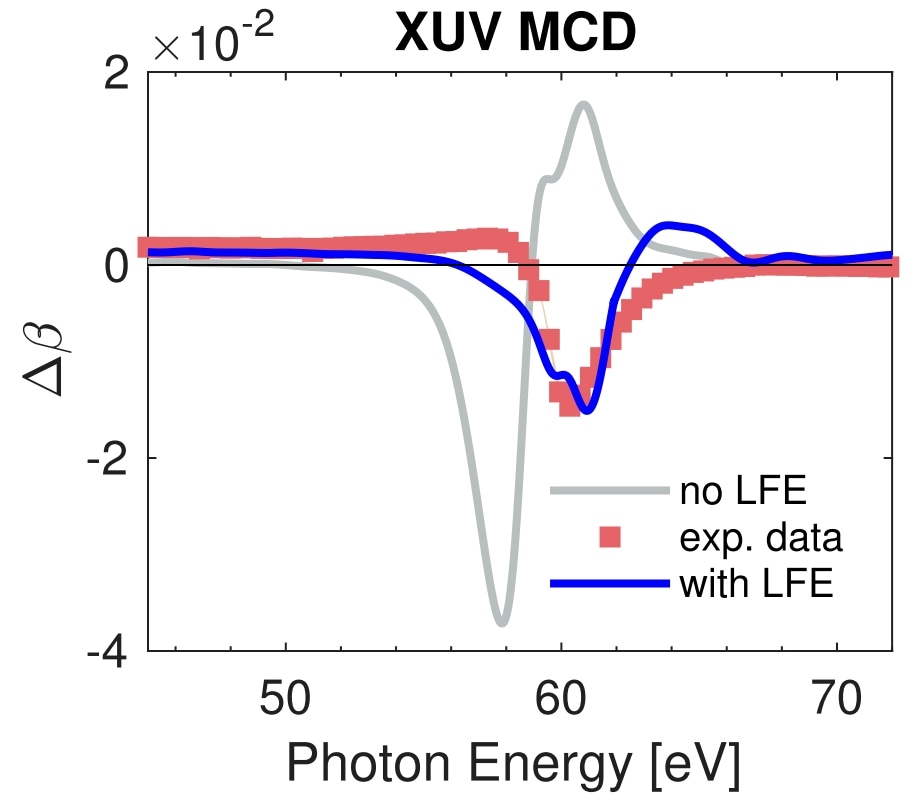Jun 4 2019
Applying extreme ultraviolet radiation to probe magnetic materials provides a complete microscopic picture of the way magnetic systems interact with light, which is believed to be the fastest way to control a magnetic material.
 Measured and calculated dichroic absorptive part of the magneto-optical function of Cobalt. Including local field effects (LFE) and many-body corrections brings the fully ab-initio theory into very good agreement with experiment. (Image credit: Max Born Institute)
Measured and calculated dichroic absorptive part of the magneto-optical function of Cobalt. Including local field effects (LFE) and many-body corrections brings the fully ab-initio theory into very good agreement with experiment. (Image credit: Max Born Institute)
Now, a research team, headed by the Max Born Institute, has provided the hypothetical and experimental foundation to interpret such kinds of spectroscopic signals. The study results have been reported in Physical Review Letters.
The study of light-matter interaction is one of the most robust methods to help physicists to interpret the microscopic realm. With regards to magnetic materials, plenty of information can be recovered through optical spectroscopy in which the energy of the separate light particles—photons—induces inner shell electrons to higher energies. The reason is this kind of method makes it possible to achieve the magnetic properties individually for the varied types of atoms present in the magnetic material and allows researchers to figure out the role and interaction of the varied constituents.
This experimental method, known as X-ray magnetic circular dichroism (XMCD) spectroscopy, has been invented in the late 1980s and normally needs a large-scale facility—an X-ray laser or a synchrotron radiation source.
To explore how magnetization reacts to ultra-short laser pulses, which happens to be the fastest means to deterministically exploit magnetic materials, smaller-scale laboratory sources have recently become available, providing ultra-short pulses in the extreme ultraviolet, or XUV, spectral range. Since XUV photons are less energetic, they excite less robustly bound electrons in the material, presenting new challenges to understand the ensuing spectra with regards to the underlying magnetization in the material.
A research team from the Max Born Institute in Berlin, along with scientists from Uppsala University in Sweden and the Max-Planck-Institute for Microstructure Physics in Halle, has now given a complete analysis of the magneto-optical response for XUV photons. The researchers integrated experiments with ab-initio calculations, which consider only the kinds of atoms and their arrangement in the material as input data.
For nickel, cobalt, and iron—the prototypical magnetic elements—the scientists successfully determined the response of these kinds of materials to XUV radiation in a more detailed manner. They eventually found that the signals, thus observed, are not merely proportional to the magnetic moment at the respective element, and that this kind of deviation is recreated in theory when the so-called local field effects are considered.
Local field effects can be understood as a transient rearrangement of electronic charge in the material, caused by the electric field of the XUV radiation used for the investigation. The response of the system to this perturbation has to be taken into account when interpreting the spectra.
Dr Sangeeta Sharma, Staff Member, Max Born Institute
Sharma provided the hypothetical description.
This latest understanding now helps to quantitatively disentangle signals from various elements in a single material.
As most functional magnetic materials are made up from several elements, this understanding is crucial to study such materials, especially when we are interested in the more complex dynamic response when manipulating them with laser pulses. Combining experiment and theory, we are now ready to investigate how the dynamic microscopic processes may be utilized to achieve a desired effect, such as switching the magnetization on a very short time scale. This is of both fundamental and applied interest.
Felix Willems, Study First Author, Staff Member, Max Born Institute